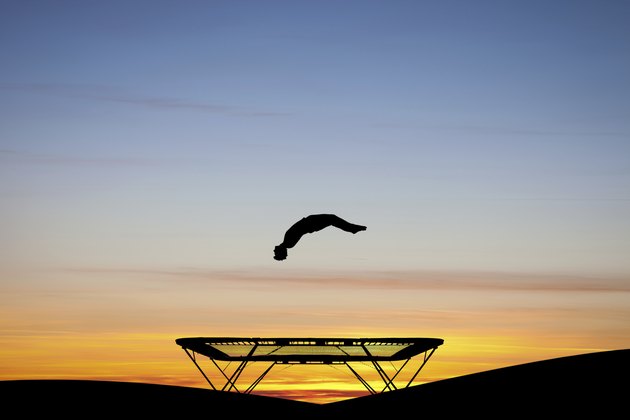Backyard trampolines can entertain even the most high-energy children for hours. The fast-paced jumping and acrobatics involved are fun for adults, too, and also offer a good aerobic workout. The question of whether you should leave your trampoline standing during the winter depends largely on personal preference and available storage space. If you leave your trampoline up, you'll need to prepare the structure for the cold and wet of the season.

Sponsored Links
Disassembly
Many trampolines are designed with durable, rust-proof materials, which means they don't have to be taken down during the winter. However, if you have the storage space, you can disassemble your trampoline and place it in a dry place. Remove the safety netting, springs, jumping mat and soft frame pads. Leave the poles that hold the netting into place, and the metal frame to which the springs and mat attach, standing in the yard.
Sponsored Links
Winterization
Winterization keeps your trampoline clean and safe if you opt to leave it up over the winter. Remove frame pads and store them indoors to keep them from getting soaked from rain or snow. The jumping surface acts as a sieve and will allow water through the bottom. However, heavy snows can build up on the mat, over-stretching the springs. Clear snow off the trampoline with a shovel or broom after each storm. Trampoline covers are not recommended, according to Super Fun Trampolines. Instead of protecting the surface, a cover locks in moisture that can cause sagging and mildew.
Wind
Trampolines can be a safety hazard in windy areas if they are not anchored down. Specialized anchor kits that include stakes that attach to the frame can help secure the trampoline to the ground. Another option is to dig trenches in the ground before the initial placement of the trampoline. Place the legs of the structure into the trenches and surround the holes with packed dirt or mulch until the frame is firmly secured in the ground, making sure the trampoline is level.
Safety
Practice trampoline safety at all times. Dry wet surfaces and allow them to dry completely before allowing friends and family members to jump. Limit jumping to one person on the mat at a time to reduce the risk of injury. Have an adult supervise children during use. The American Academy of Orthopaedic Surgeons does not recommend trampolining for children younger than 6 years old.
REFERENCES & RESOURCES Super Fun Trampolines: Trampoline FAQ JumpSport: Trampoline Product and Help FAQs American Academy of Orthopaedic Surgeons: Position Statement: Trampolines and Trampoline Safety Trampolining; Sue Freeman